Best EHR Systems of 2026 : Top 10 Solutions for Healthcare Providers
Today, Electronic Health Record (EHR) systems are no longer just digital versions of paper charts—they have become the backbone of effective, patient-centered care.
Recent stats show that nearly 88% of office-based physicians use EHRs, with 78% relying on certified systems.
Whether you’re running a small practice or managing a multi-location hospital system, choosing the right EHR can make all the difference.
So, to empower you to make a confident decision, in this guide, we’ll dive into the top 10 EHR systems of 2026.
We’ll break down their features, pricing, strengths, weaknesses, who they’re best suited for, and much more. Let’s begin by understanding the basics.
| Parameter | OmniMD | Athenahealth | Oracle Health (Cerner) | NextGen Healthcare | Allscripts / Veradigm | Epic Systems | eClinicalWorks (eCW) | DrChrono | AdvancedMD | Kareo / Tebra |
| Core Features | Cloud EHR, PM, RCM, telehealth, patient engagement, AI automation. | Cloud-based EHR + PM + RCM; strong patient engagement and telehealth. | Enterprise EHR for hospitals; clinical documentation, interoperability, analytics. | Ambulatory EHR, PM, population health, RCM. | Ambulatory EHR + PM with analytics and patient engagement. | Enterprise-wide EHR with specialty modules, interoperability tools, and patient portal (MyChart). | Ambulatory EHR + PM with patient engagement and telehealth. | Mobile-first EHR; PM, customizable templates, telehealth, billing. | Cloud-based EHR, PM, billing, telemedicine. | EHR + PM for small practices; patient engagement, scheduling, billing. |
| Customization | Specialty templates, customizable workflows and forms. | Configurable templates and workflows. | Highly configurable during enterprise implementations. | Specialty-specific templates and customizable workflows. | Customizable ambulatory workflows and templates. | Deep configurability across clinical, financial, and specialty workflows. | Customizable clinical templates and workflows. | Drag-and-drop custom clinical forms; flexible templates. | Specialty templates and configurable EHR workflows. | Customizable templates for small practices. |
| Scalability & Interoperability | Suitable for practices of all sizes; integrates with labs, billing, and third-party systems. | Scales from small to large ambulatory groups; strong network interoperability. | Designed for large hospitals and health systems; broad interoperability. | Scales for small to large ambulatory and specialty groups. | Scalable ambulatory system with interoperability frameworks. | Scales for large, multi-site health systems; industry-leading interoperability. | Works for small to large ambulatory groups; interoperability via external connections. | Best for small practices; integrates with billing and telehealth tools. | Scales for independent practices and groups; cloud interoperability. | Designed for small practices; offers interoperability for basic workflows. |
| Cost Structure | Subscription-based; tailored pricing (quote-based). | Subscription/contract pricing; varies by modules/services. | Enterprise contracts; customized pricing for hospital systems. | Subscription-based; pricing varies by organization size & modules. | Contract-based pricing; varies by product suite. | Enterprise-level contracts; pricing varies by scale & implementation scope. | Subscription-based; pricing varies by deployment and modules. | Tiered subscription pricing; optional RCM add-ons. | Subscription-based modular pricing. | Subscription pricing for small practices; tiered packages. |
| Usability & Support | User-friendly, specialty workflows; implementation + ongoing support. | Streamlined cloud UI; onboarding, training, and customer support. | Enterprise UI with structured training & implementation support. | Intuitive cloud interface; training and support available. | Functional UI with training & support options. | Widely used enterprise UI; robust training and support programs. | Ambulatory-focused UI; training and customer support available. | Mobile-friendly UI; training and customer support. | Clean ambulatory interface; training & support offered. | Simple UI designed for small practices; support provided. |
| Best Fit For | Small to large ambulatory clinics needing all-in-one, AI-enhanced workflows. | Ambulatory groups wanting integrated EHR+PM+RCM in the cloud. | Hospitals, IDNs, and large enterprise health systems. | Multi-specialty ambulatory practices and specialty groups. | Ambulatory practices needing customizable EHR/PM. | Large hospitals, academic medical centers, multi-site health systems. | Ambulatory practices from small to large groups. | Small, mobile-first clinics, solo practices, concierge care. | Independent practices, PT/OT, mental health, urgent care. | Small practices, behavioral health, new independent clinics. |
What is an EHR System?
At its core, an Electronic Health Record (EHR) system is a digital solution for securely storing and managing patient health information.
But modern EHRs go well beyond record-keeping. They’re packed with tools designed to make your work easier and more efficient.
Here are some of the key features you’ll find in today’s EHR systems:
- Telehealth Integration
- AI-Driven Analytics
- Patient Engagement
- Lab Integration
- E-prescribing
- Medical Billing
- Revenue Cycle Management
Why Does Choosing the Right EHR Matter?
On a critical note, selecting the right EHR isn’t just about ticking a box. It’s about finding a tool that genuinely helps you and your team work smarter, not harder.
A great EHR can:
- Boost operational efficacy by up to 40%.
- Cut patient wait times by 30%.
- Improve compliance with regulatory standards and data security.
That means, whether you’re focused on care coordination, reducing operational headaches, or staying on top of industry regulations, the right EHR makes it all effortless.
To help you pick the best one, we’ve rounded up 5 of the most popular EHR systems and included valuable details about each one.
By the time you’re done reading, we are assured that you’ll have a clearer idea of which one fits your organization’s unique needs.
1. OmniMD
Founded in The Year: 2001
Official Website: OmniMD
Ratings: 4.3 out of 5 stars, based on 38 user reviews.
Certifications and Compliance: ONC Certified, HIPAA Compliant, and MIPS/MACRA Ready
Suitable For: Clinics, small and large group practices, multi-specialty practices, and healthcare organizations seeking a fully integrated healthcare IT solution.
Free trial: Not available
Cost: Versatile pricing models, including subscription-based and custom packages attuned to practice needs and size
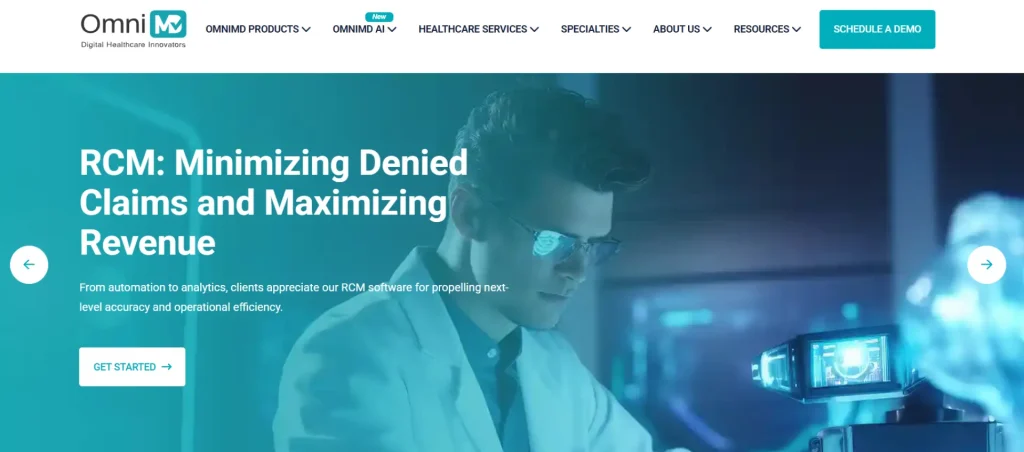
Established in 2001, OmniMD entered the market with a vision to alleviate the administrative burden on healthcare professionals and improve patient care outcomes.
The company began by offering an advanced EHR system, which later expanded into a comprehensive suite of solutions, including practice management, revenue cycle management (RCM), patient engagement tools, and telehealth services.
Its unique approach lies in its commitment to integrating sophisticated technology with user-friendly interfaces. For example, the company uses AI to assist in clinical documentation and simplify procedures, reducing time spent on repetitive tasks.
Today, omniMD serves over 12,000 healthcare professionals and 600+ healthcare facilities across the USA. Here’s how its EHR distinguishes itself.
Feature #1: Fully Integrated Cloud-Based EHR
The cloud-based architecture provides unparalleled flexibility and ease of use. With no need for costly IT infrastructure, practices can scale effortlessly and access patient data securely from anywhere. Automatic updates ensure no downtime, keeping providers focused on care.
For example, a multi-location primary care practice can deploy OmniMD without investing in servers or additional hardware, enjoying easy-to-use functionality across all sites.
Feature #2: AI-Powered Clinical Decision Support
AI-driven tools deliver dynamic clinical decision support, helping providers identify high-risk patients and optimize treatment plans. Unlike others that rely on static rule-based systems, OmniAI adapts on-the-fly to individual patient data.
For example, a family practice can use OmniAI to highlight patients at risk for chronic conditions and suggest preventive care, improving outcomes and reducing complications.
Feature #3: Specialty-Specific Customization
The EHR stands out with its personalized plans for over 30 medical specialties, offering practices a precise fit for their clinical requirements. This customization saves time and ensures accuracy in documentation, outperforming generic systems.
For example, an orthopedic clinic can rely on OmniSpecialty’s templates for surgical notes and imaging integration, improving capability, and reducing manual entry errors.
Feature #4: Unified Revenue Cycle Management (RCM)
The RCM tools are fully embedded within its EHR platform, assimilating financial pathways without needing external add-ons. Features like rapid claim validation and automated denial tracking provide a comprehensive solution for revenue management.
For example, a cardiology practice can use OmniRCM to track claims performance first-hand, reduce denials, and improve cash flow—all from within the same system.
Additionally, what sets OmniMD apart is its ability to cater to the specific needs of diverse medical practices. From leveraging cloud-based infrastructure to ensuring mobility and cost-effectiveness, using AI to deliver synchronous clinical insights, or offering specialty-specific templates, the company goes beyond the basics of an EHR system.
But, given the complexity of choosing the right EHR, it’s essential to weigh both the strengths and potential limitations of any system. Thus we’ve evaluated the pros and cons below:
Pros |
Cons |
| Next-Generation AI Assistance | High-End Features May Be Underused |
| Voice-Driven Clinical Documentation | Periodic Learning Updates Needed |
| Precision Medicine Tools | Dependence on Training for Maximum ROI |
| Robust interoperability | |
| Dynamic Specialty Modules | |
| Built-In AI-Driven Revenue Optimization | |
| Predictive Cybersecurity Infrastructure |
2. Athenahealth
Founded in The Year: 1997
Official Website: athenahealth
Ratings: 4.1 out of 5 stars, based on 179 user reviews.
Certifications and Compliance: ONC Certified and HIPAA Compliant
Suitable For: Medical practices of all sizes, including independent practices, multi-specialty groups, and health systems.
Free Trial: Not available
Cost: Operates on a percentage-of-collection pricing model, with costs varying based on practice size and specialty.
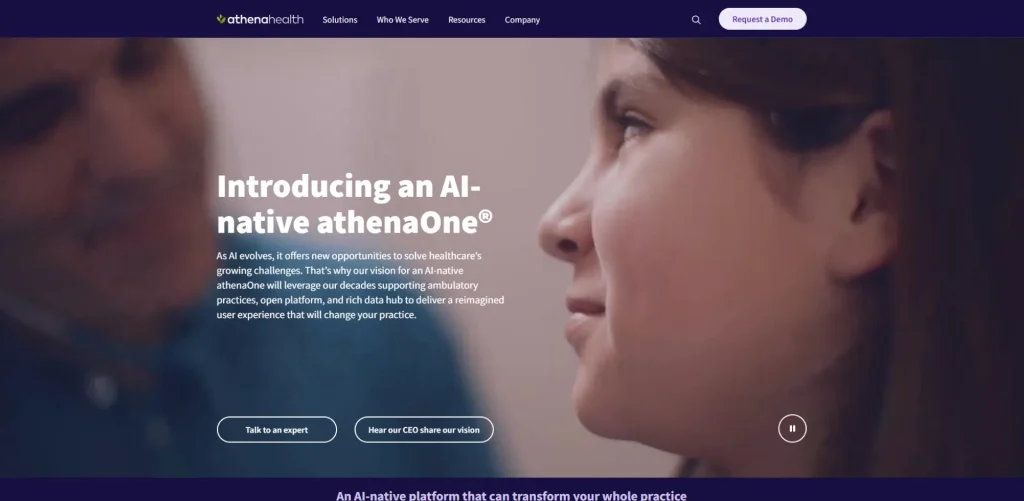
If you do not know already, you might be surprised that Athenahealth wasn’t originally conceived as a healthcare IT company.
In 1997, when its co-founders Jonathan Bush and Todd Park started a women’s health practice called Athena Women’s Health, they faced significant challenges in managing the administrative and billing processes. Which were largely manual and inefficient at the time.
To solve their own problems, they developed a cloud-based billing system. This tool turned out to be so effective that it became the foundation of Athenahealth as we know it today.
Currently, the company offers extensive healthcare IT solutions, including EHR, practice management, and revenue cycle solutions.
For this guide, we will be looking at its EHR system’s most striking features.
Feature #1: Cloud-Based Architecture
This cloud-based architecture offers scalability and minimal IT. It allows for easy updates without downtime, ensuring providers always have access to the latest updates.
For example, a small primary care practice with limited IT resources can deploy athenaOne without investing in expensive servers or hardware.
Feature #2: RCM Integration
The EHR tightly integrates with RCM tools under athenaCollector. This integration cuts down financial sequences by automating billing and claims processing.
For instance, a multi-specialty practice can use athenaCollector to automatically verify insurance, process claims, and track revenue performance—all within the same system.
Feature #3: Patient Engagement Analytics
The company places a strong emphasis on patient engagement through athenaCommunicator, which uses data-driven insights to improve patient interactions.
For example, a clinic aiming to reduce no-show rates can automate reminder messages for upcoming appointments and follow up with satisfaction surveys to improve care delivery.
Feature #4: Claims Data and Payer Insights
This feature helps practices optimize their financial strategies by giving them visibility into claims performance and payer behavior.
For instance, a provider can compare its claim approval rates with industry benchmarks to identify areas of improvement in documentation or coding.
But, as we are aware, no system is perfect, and the same holds for Athenahealth’s EHR. While its capabilities are impressive, it’s essential to consider both the advantages and limitations before making a decision.
Below, we’ve explored the pros and cons to help you determine if it’s the right fit for your practice.
Pros |
Cons |
| Real-Time Performance Insights | Steep Initial Investment |
| Dedicated Focus on Small to Mid-Sized Practices | Lack of Predictable Pricing |
| Adaptive Learning Features | Limited Customization for Workflows |
| Specialty-Specific Features | Restricted Offline Capabilities |
| Proactive Compliance Updates | Lack of Advanced Reporting Tools |
| Customer Support and Training | Occasional System Updates Affecting Workflow |
3.Oracle Health (Formerly Cerner)
Founded in The Year: 1979
Official Website: Oracle Health
Ratings: 4.0 out of 5 stars, based on 143 user reviews
Certifications and Compliance: ONC Certified and HIPAA Compliant
Suitable For: Hospitals, health systems, ambulatory clinics, and other healthcare organizations seeking comprehensive IT solutions.
Free Trial: Not available
Cost: Pricing varies based on your organization’s size and specific expectations.

Oracle Health, formerly known as Cerner, is a powerhouse in the EHR world. After being acquired by Oracle in 2021, it’s been delivering even more impactful solutions for healthcare providers of all sizes.
Some of its most notable EHR features include:
Feature #1: Comprehensive Clinical Documentation
This flagship solution allows providers to document patient care in real time with customizable templates for clinical workflows.
For example, during hospital rounds, a physician can use this module to review patient history, add progress notes, and update treatment plans.
Feature #2: Interoperability
This tool connects healthcare organizations to external systems, such as labs, pharmacies, and imaging centers, to exchange patient data effortlessly.
For instance, a clinic partnered with Diagnostics Center can receive lab test results directly into their patient’s chart, enabling timely decisions and avoiding duplicate tests.
Feature #3: Patient Portal
This patient-facing portal provides users with secure access to their health records, appointment scheduling, and direct messaging with their care team.
For instance, a diabetic patient can view recent blood sugar readings logged by their physician, communicate concerns, and request prescription refills – all from the comfort of their home.
Feature #4: Mobile Accessibility
This mobile app allows physicians to access patient records, document care, and place orders directly from a tablet or smartphone.
For example, in a busy emergency room, a doctor can use this feature to quickly review a patient’s allergies and past medical history before prescribing medication.
While its feature set is undeniably impressive, it’s not just about the features. It’s about how they work in real-life scenarios, complementing your organization’s requirements, size, and resources.
Here’s a glance at the platform’s strengths and areas where it might not be a perfect fit.
Pros |
Cons |
| Advanced Interoperability | High Cost |
| Comprehensive Clinical Documentation | Steep Learning Curve |
| Patient-Centric Engagement | Complex Implementation |
| Mobile Accessibility | Over-Specialization |
| Scalable for Large Organizations | Reliance on Oracle Ecosystem |
| AI-Powered Analytics | Lack of Free Trial |
| Trusted Legacy and Compliance | Customization Challenges |
4. NextGen Healthcare
Founded in The Year: 1974
Official Website: NextGen Healthcare
Ratings: 4.0 out of 5 stars, based on 150 user reviews
Certifications and Compliance: ONC Certified and HIPAA compliance Compliant
Suitable For: Ambulatory practices of all sizes, including primary care and various specialties
Free Trial: Not available
Cost: Pricing is customized based on the specific needs and size of the practice
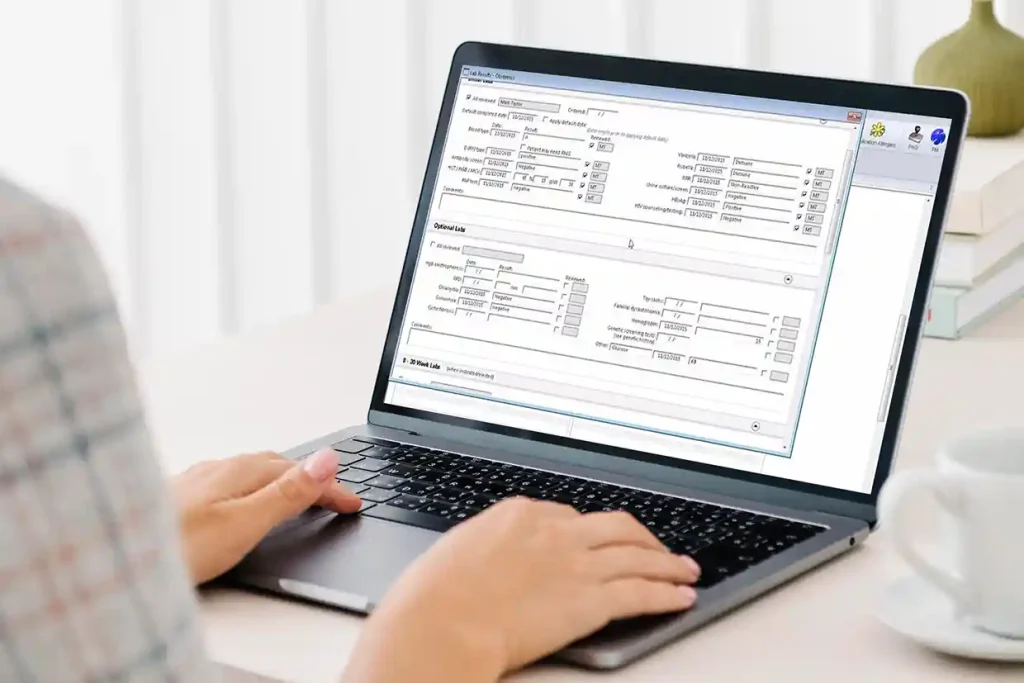
NextGen Healthcare was founded in 1974 as Quality Systems, Inc., focusing on dental practice management software before branching into medical practice management and EHR solutions. It rebranded to NextGen Healthcare in 2018 to align more closely with its flagship product line and evolving mission.
Unlike some larger institutions like Epic or Cerner, the company has carved a niche by focusing on small to medium-sized practices, ambulatory care, and specialty providers, making its tools more tailored to these groups.
Let’s see how its EHR features embody this focus on adaptability and optimized support.
Feature #1: Specialty-Specific Templates
These templates are designed to meet the unique functions and compliance needs of various specialties.
For example, a dermatology practice can use pre-built templates customized for skin exams and procedures, reducing the time spent on charting and ensuring accurate documentation for billing and coding.
Feature #2: Integrated Telehealth Platform
The integrated telehealth platform enables providers to offer remote care directly from the EHR. It eliminates the need for third-party tools, providing a smooth experience for both providers and patients.
For instance, an ambulatory care clinic can conduct follow-up appointments via virtual visits, allowing patients to receive care from home while providers can access patient records in real time during the session.
Feature #3: Population Health Management
The tool empowers practices to manage patient populations proactively by identifying care gaps and coordinating interventions.
For example, a primary care provider can identify high-risk diabetic patients and automate reminders for lab tests, ensuring timely follow-ups and better health outcomes.
Feature #4: Interoperability
The platform facilitates effortless data exchange between providers, hospitals, and labs, enhancing care coordination across the continuum.
For instance, a specialist can securely receive and review patient records from a referring physician, enabling quicker and more informed decision-making.
While the features of NextGen Healthcare showcase their capability to address diverse practice needs with precision and innovation, it’s important to consider the complete picture.
Every EHR solution, no matter how comprehensive, has its own set of strengths and limitations that can influence its effectiveness in specific healthcare settings.
To truly understand how this EHR stands out – or where it may fall short – we’ve compiled a list of its pros and cons.
Pros |
Cons |
| Customizable Specialty Workflows | Occasional System Sluggishness |
| Patient-Centric Design | Overwhelming Customization Options |
| Regulatory Compliance Tools | Less Market Penetration in Large Facilities |
| Advanced Interoperability with HIEs | Steep Learning Curve for Advanced Features |
| AI-Driven Insights | Mobile App Limitations |
5. Veradigm (Formerly Allscripts)
Founded in The Year: 1986
Official Website: Allscripts
Ratings: 2.9 out of 5 stars, based on 138 user reviews.
Certifications and Compliance: ONC Certified and HIPAA Compliant
Suitable For: Various healthcare organizations, including hospitals, physician practices, and specialty clinics
Free Trial: Not available
Cost: Pricing is not publicly disclosed

Allscripts began in 1986 as a provider of prepackaged medications for physicians to dispense at the point of care. It wasn’t until the late 1990s and early 2000s that the company shifted its focus to electronic health records (EHR) and healthcare IT solutions.
It’s notable that even before mobile health apps became commonplace, the company introduced mobile EHR capabilities. Its early mobile platform allowed healthcare providers to access patient records on Palm and Pocket PC devices, marking it as a pioneer in mHealth technology.
This pioneering spirit is also evident in its comprehensive suite of EHR features. We have mentioned a few standouts below.
Feature #1: Dynamic Workflows
This allows practices to personalize the EHR interface and functionality based on their unique requirements, optimizing competence, and reducing administrative burden.
For instance, a family medicine clinic can configure methods to prioritize pediatric vaccination schedules and synchronize follow-up appointment reminders, enhancing the practice’s operational output rate.
Feature #2: Integrated Analytics and Reporting
This enables healthcare organizations to harness the power of data for decision-making through concurrent dashboards and advanced reporting tools.
For example, a multispecialty practice can analyze patient data trends to identify recurring chronic disease patterns and allocate resources more effectively, improving both patient outcomes and financial performance.
Feature #3: Patient Engagement Solutions
The platform empowers patients to actively participate in their healthcare journey by providing them with easy access to their medical records, secure messaging with providers, and self-scheduling capabilities.
For example, a cardiology practice can use the platform to enable patients to track their cholesterol levels, communicate with their care team, and book follow-up visits online, enhancing patient satisfaction and engagement.
Feature #4: Open Platform Interoperability
The platform encourages interoperability by enabling smooth integration with third-party applications and other health IT systems through its powerful API ecosystem.
For instance, a healthcare organization can integrate a third-party remote patient monitoring app to collect data from wearable devices and sync it directly with the Allscripts EHR, improving chronic care management without disrupting priorities.
But it’s not just about what the platform can do, but how effectively it aligns with an organization’s capacity. In other words, it can be transformative when used skillfully, but overwhelming if handed to a novice without guidance.
To help you unlock its full potential, below we’ve mentioned the upsides and potential challenges of embracing Allscripts in your practice.
Pros |
Cons |
| Customizability Across Diverse Specialties | Steep Learning Curve |
| Open Platform for Integration | Complex Configuration Process |
| Comprehensive Data Insights | High Cost of Ownership |
| Scalable for Growing Practices | Occasional System Downtime |
| Patient Engagement Focus | Inconsistent User Interface |
| Global Presence with Local Support | Limited Built-In Telehealth Features |
| Task Automation | Customer Support Challenges |
6. Epic Systems
Founded in The Year: 1979
Official Website: https://www.epic.com/
Ratings: 4.0
Certifications and Compliance: ONC Certified, HIPAA Compliant
Suitable For: Large hospitals, IDNs (Integrated Delivery Networks), academic medical centers, and multi-facility health systems
Free Trial: Not available
Cost: Premium pricing; customized enterprise contracts
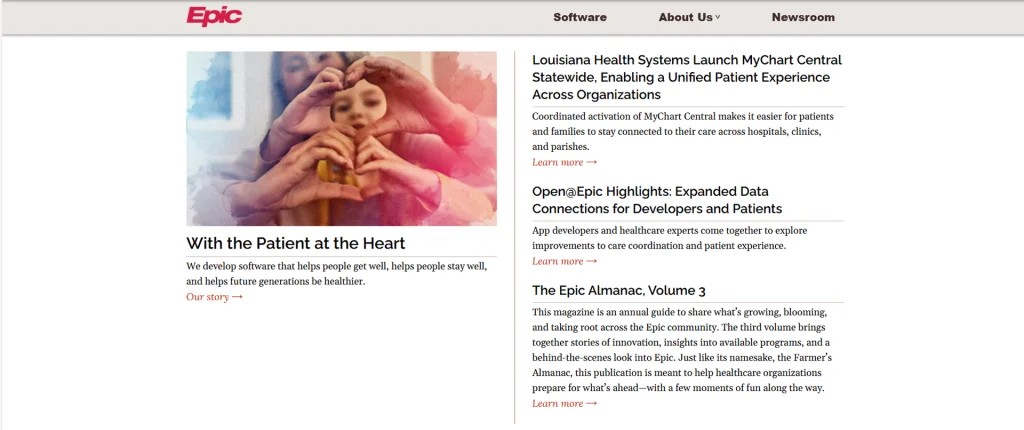
Epic Systems is one of the most recognized names in healthcare technology, particularly in the hospital and enterprise sector. Unlike mid-market EHRs designed for small practices, Epic is engineered to handle enormous patient volumes, multi-location workflows, and advanced clinical systems under one umbrella.
Its reputation is built on deep interoperability, high reliability, and feature-rich modules customized for everything from oncology to cardiology to behavioral health.
Some of its most notable EHR capabilities include:
Feature #1: MyChart ( Leading Patient Portal)
Epic’s MyChart is considered one of the strongest patient engagement tools in the industry. Patients can view lab results, communicate with providers, manage medications, and schedule appointments within minutes.
Feature #2: Care Everywhere ( Interoperability)
Epic’s Care Everywhere allows data exchange between thousands of Epic and non-Epic systems.
That means, an ER doctor can immediately view a patient’s history from another health system, critical in emergencies.
Feature #3: Specialty Modules
Epic offers dedicated modules for oncology, pediatrics, cardiology, behavioral health, and more.
For example, Epic Beacon simplifies chemotherapy order management for oncology practices.
Feature #4: Integrated Revenue Cycle (Resolute)
Resolute simplifies billing for high-volume facilities, with tools for claims, coding, and charge capture.
For instance, a multi-hospital network can manage consolidated billing across all its facilities.
Pros |
Cons |
| Industry-leading interoperability | Extremely expensive |
| Strong specialty modules | Not designed for small practices |
| Highly secure ecosystem | Long implementation cycles |
| Best-in-class patient portal | Requires extensive IT support |
7. eClinicalWorks (eCW)
Founded in The Year: 1999
Official Website: https://www.eclinicalworks.com/
Ratings: 3.7
Certifications and Compliance: ONC Certified, HIPAA Compliant
Suitable For: Small practices, medium-sized groups, multi-specialty clinics
Free Trial: Not available
Cost: Subscription-based; transparent pricing starts around industry averages
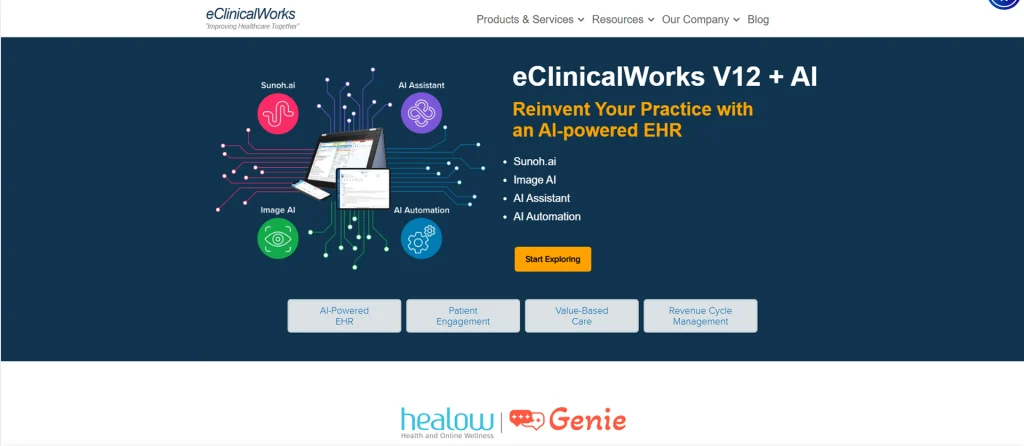
eClinicalWorks is one of the largest ambulatory EHR vendors, serving over 130,000 physicians and 800,000 medical professionals globally. The company is known for its comprehensive EHR and practice management combo and competitive pricing.
Some of its most notable EHR features include:
Feature #1: Healow Patient Engagement Suite
Healow provides telehealth, online scheduling, reminder tools, and remote patient monitoring.
For example, a pediatric clinic can allow parents to check immunization records and schedule appointments via the Healow app.
Feature #2: PRISMA – Searchable Health Information
PRISMA aggregates data across external healthcare systems into a unified timeline.
For example, a provider can view hospital discharge notes, labs, and imaging from different systems in one place.
Feature #3: Chronic Care & Population Health Tools
Tools for care gap closure, analytics, and outreach programs.
For instance, a primary care group can automate chronic disease registries and follow-ups.
Feature #4: Revenue Cycle Tools
eCW integrates coding, billing, denial tracking, and claim scrubbing.
For example, billing teams can reduce denials with automated error checks before claims submission.
Pros |
Cons |
| Strong patient engagement tools | Interface can feel outdated |
| Competitive pricing | Support responsiveness varies |
| Broad functionality for ambulatory care | Complex configurations for new users |
| Integrated telehealth |
8. DrChrono
Founded in The Year: 2009
Official Website: https://www.drchrono.com/
Ratings: 4.0
Certifications and Compliance: ONC Certified, HIPAA Compliant
Suitable For: Small practices, solo providers, startups, concierge medicine
Free Trial: Sometimes available (depends on plan)
Cost: Tiered subscription-based pricing
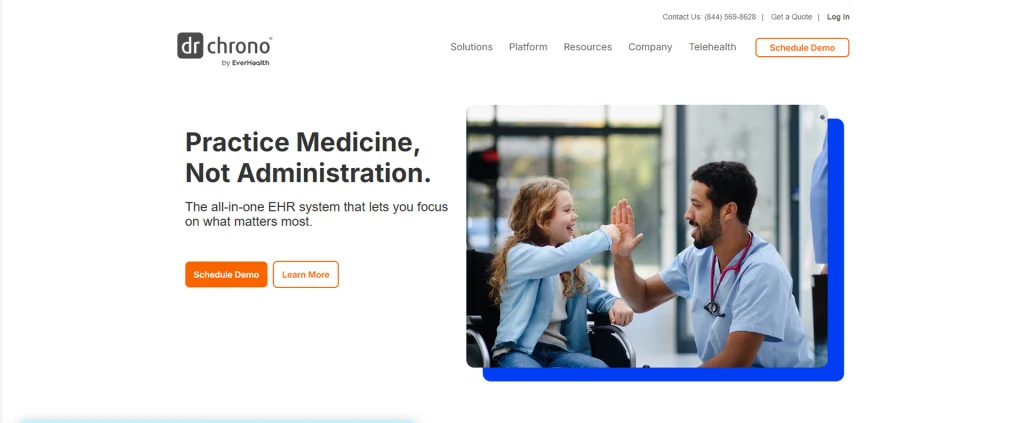
DrChrono is one of the first EHR platforms built natively for iPad and iPhone, making it ideal for mobile-first practices, traveling physicians, direct care models, and clinics that prioritize portability.
Some of its most notable EHR features include:
Feature #1: Native iPad EHR
Providers can chart, order labs, and manage patients directly from an iPad.
For example, an urgent care provider can document while standing bedside in real time.
Feature #2: Customizable Clinical Forms
Drag-and-drop form builders allow fully customizable templates.
For instance, a dermatology clinic can create custom lesion mapping forms.
Feature #3: Integrated RCM Services
DrChrono offers billing tools, claim scrubbing, and outsourced RCM services.
For example, small clinics can outsource billing without hiring internal teams.
Feature #4: Telehealth and Online Scheduling
Video visits and appointment management are built in.
For example, a mental health provider can conduct virtual therapy sessions via DrChrono.
Pros |
Cons |
| Ideal for mobile-first workflows | Not suitable for large enterprises |
| Highly customizable forms | Learning curve for advanced features |
| Simple, modern UI | Limited specialty depth compared to major vendors |
| Great for small practices |
9. AdvancedMD
Founded in The Year: 1999
Official Website: https://www.advancedmd.com/
Ratings: 3.6
Certifications and Compliance: ONC Certified, HIPAA Compliant
Suitable For: Independent practices, urgent care, mental health, physical therapy
Free Trial: Not available
Cost: Subscription-based; modular pricing
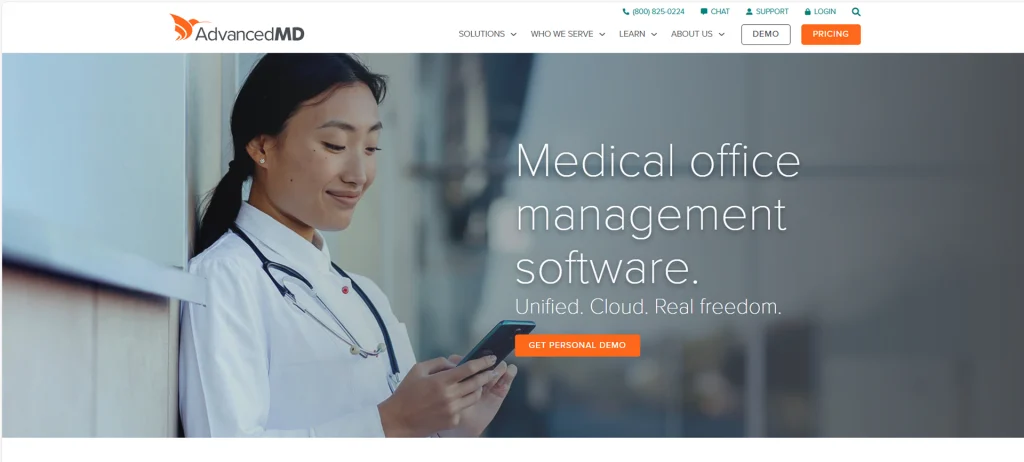
AdvancedMD is widely known for offering end-to-end solutions tailored to independent practices and outpatient settings. Its flexible pricing and modular add-ons make it attractive for practices looking to scale gradually.
Some of its most notable EHR features include:
Feature #1: Modular Practice Management
Scheduling, claims, reporting, and billing can be bundled or purchased individually.
For example, a new clinic can start with EHR and scheduling, then add RCM later.
Feature #2: Telemedicine Suite
Built-in telehealth with patient self-check-in.
For example, mental health providers can conduct virtual visits and collect pre-session forms.
Feature #3: Smart EHR Templates
Custom templates for specialties like orthopedics, PT, and behavioral health.
For example, PTs can document range-of-motion tests quickly.
Feature #4: Practice Analytics
KPI dashboards for productivity, billing, and care metrics.
For instance, administrators can track financial performance across multiple providers.
Pros |
Cons |
| Flexible and scalable | Add-on pricing increases costs |
| Designed for ambulatory workflows | Interface can feel complex |
| Strong telehealth features | Slower performance during peak hours |
| Good analytics and reporting |
10. Kareo (Now Tebra)
Founded in The Year: 2004
Official Website: https://www.tebra.com/
Ratings: 3.7
Certifications and Compliance: ONC Certified, HIPAA Compliant
Suitable For: Small practices, mental health clinics, independent medical groups
Free Trial: Not available
Cost: Subscription-based
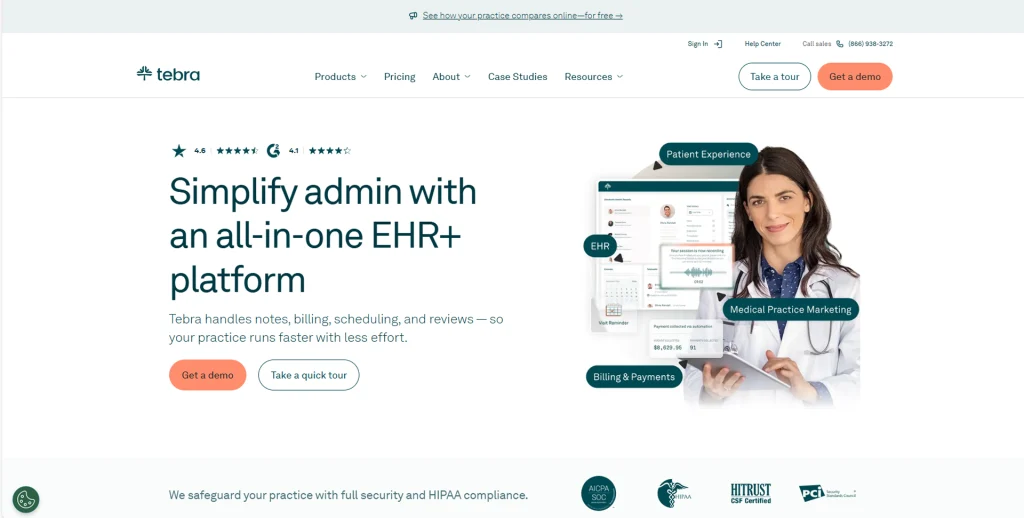
Kareo, now part of Tebra after merging with PatientPop, focuses on helping independent medical practices digitize operations, improve patient experience, and simplify billing.
Some of its most notable EHR features include:
Feature #1: Integrated EHR + Billing
Kareo’s unified workflow is especially beneficial for small and growing practices.
For example, a solo provider can chart, code, and bill without switching systems.
Feature #2: Tebra Patient Experience Platform
This includes online scheduling, patient intake, and marketing automation.
For instance, new practices can attract patients through automated digital campaigns.
Feature #3: Mental Health Support
Kareo is widely used in behavioral health because of simple templates and notes.
For example, therapists can customize SOAP note templates easily.
Feature #4: Mobile Functionality
Providers can use mobile apps for charting, messaging, and billing.
Great for practices with remote or flexible workflows.
Pros |
Cons |
| Affordable for small practices | Not ideal for large multispecialty groups |
| Strong billing + RCM suite | Some limitations in advanced analytics |
| Easy onboarding | Occasional interface lag |
| Great for mental health and small clinics |
Specialty-Specific EHRs: What You Need to Know
When it comes to specialties, there are very granular divisions that most EHR software companies seem to struggle with. For example, under cardiology itself, there are numerous sub-specialties, such as interventional cardiology, electrophysiology, heart failure, and transplant cardiology, each having its own module requirements.
Thus, to ensure your EHR doesn’t fall short of your expectations, we’ve compiled a list of features you must inquire about if you deal with high-risk conditions.
Cardiology EHR: Look for features that ease your workflow
- Easy connection with diagnostic tools like ECG, echocardiograms, and stress tests.
- Access to high-quality images with DICOM and PACS integration.
- Tools to manage chronic conditions like high blood pressure and heart failure.
- Customizable templates for cardiology notes and procedures.
- Built-in tools to calculate heart health risks and support decisions.
- Data analysis for tracking heart health in large groups of patients.
- Links to labs, pharmacies, and other healthcare systems.
Recommended best EHRs for cardiology by our experts : OmniMD, NextGen Healthcare and Cerner PowerChart
EHR/EMR for psychiatry: Prioritize patient-first features
- Ready-to-use, customizable templates for psychiatric evaluations and treatment plans.
- Tools for mental health assessments like PHQ-9 and GAD-7.
- Secure telepsychiatry features that follow HIPAA and 42 CFR Part 2 rules.
- E-prescribing for mental health medications, including tracking-controlled substances.
- Access to state-specific Prescription Drug Monitoring Programs (PDMP).
- Patient tools like portals and dashboards to track progress.
- Strong data security to protect sensitive mental health information.
- Automated scheduling and appointment reminders.
- Built-in support for billing and reimbursements.
Recommended best EHRs for psychiatry by our experts : SimplePractice, OmniMD and TheraNest
EHR for Urgent Care: Consider features that save you time
- Quick documentation tools with ready-to-use templates for common health issues.
- Instant insurance checks to confirm coverage.
- Lab and imaging device connections for on-the-spot test results.
- Patient queue systems to organize visits smoothly.
- Pre-designed workflows for tasks like DOT exams and drug tests.
- Automatic coding and billing to avoid mistakes.
- Tools to manage referrals and approvals easily.
- Smart scheduling with waitlist options.
Recommended best EHRs for urgent care by our experts : OmniMD, DocuTAP (Experity) and AdvancedMD
How to Choose the One That Best Meets Your Goals
Choosing the perfect EHR system can feel like a high-stakes decision – it’s not just software; as we mentioned, it’s the backbone of your practice’s operations and patient care.
In a world where healthcare providers are constantly juggling compliance demands, proficiency goals, and the need for enhanced patient experience, the right EHR can be your most powerful ally.
But how do you navigate the crowded market of solutions and pinpoint the one that truly aligns with your goals?
Start by asking the big questions: What problems are you solving?
What features are essential, and what can you live without?
And most importantly, how will this system grow with your practice in the years to come?
Here are five practical steps to guide your decision.
Step#1 : Define Your Goals
Identify your priorities, whether it’s improving patient engagement, reducing administrative burden, or ensuring impeccable compliance.
Step#2 : Involve Key Stakeholders
Include input from your team, such as clinicians, front desk staff, and administrators, to ensure the EHR meets everyone’s needs.
Step#3 : Focus on Integration
Look for systems that consolidate EHR, RCM, and PM functionalities to refine the course of actions and reduce third-party dependencies.
Step#4 : Check for Usability
A user-friendly interface is vital to minimize training time and avoid frustration.
Step#5 : Review Vendor Support
Ensure the vendor provides reliable customer service and ongoing training.
For a deeper dive into evaluating EHR systems and making the best choice for your practice, check out our comprehensive guide: How to Find the Right EHR.
This resource provides actionable insights and expert advice for healthcare providers like you.
Conclusion: Why Comparison Matters?
We believe the best EHR system is the one that feels less like software and more like a silent ally, empowering you to grow, innovate, and make every patient interaction count. That’s why we’ve gone beyond simply presenting the top players like OmniMD, athenahealth, Oracle Health, NextGen Healthcare, and Allscripts.
To make your decision-making process even smoother, we’ve developed a detailed comparison table. This table provides a clear, side-by-side view of the top systems across multiple parameters.
Disclaimer: We’ve built this resource with healthcare professionals in mind, ensuring that it saves you time and offers clarity in your decision-making process. However, the comparison is based on independent research conducted by our team, leveraging publicly available information and vendor-provided resources. Features and pricing details may vary; we recommend reaching out to the respective vendors for the most accurate and up-to-date information.

Choose the Best EHR for Your Clinic
Streamline your clinical practice and improve patient care effortlessly
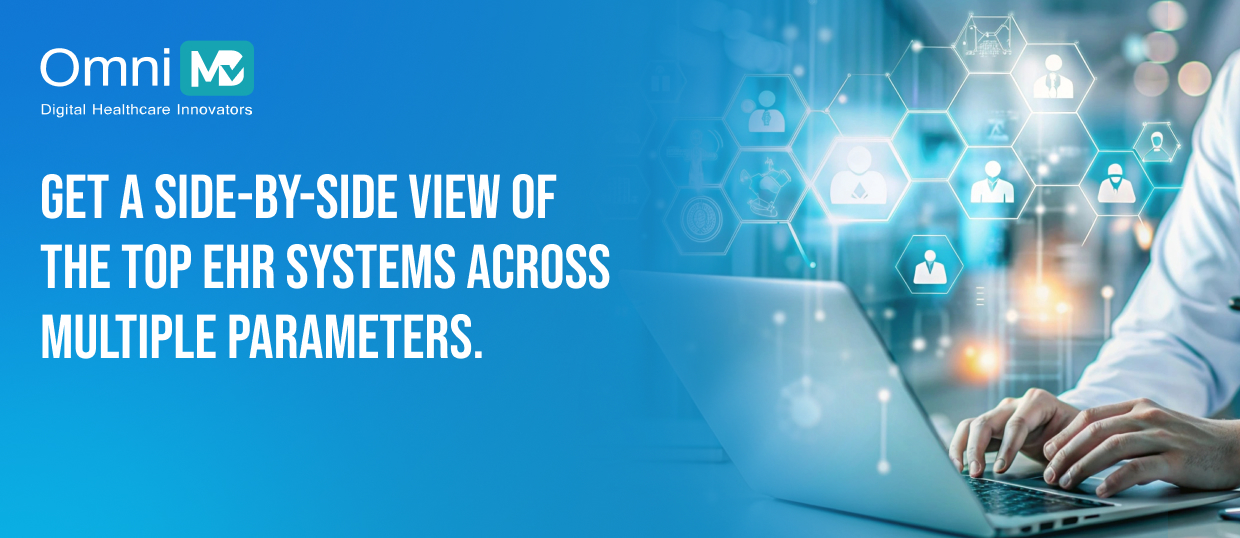
 Written by Dr. Giriraj Tosh Purohit
Written by Dr. Giriraj Tosh Purohit